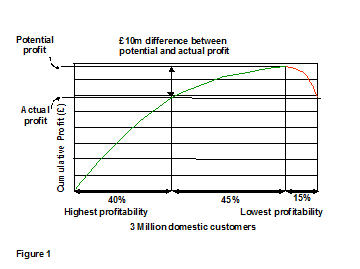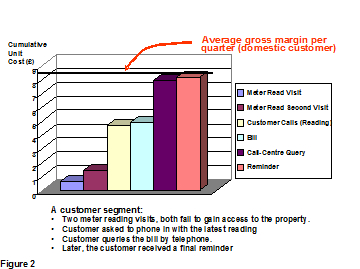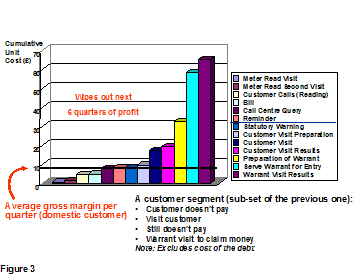Changing customer behaviours to increase profitability
A UK energy supplier was under severe pressure to improve its profitability, as well as increase the customer base. The directors had already considered a percentage reduction in staff across all parts of the business but the risk of arbitrarily reducing service levels was not one they wished to contemplate when there was already a net outflow of customers. Two ways forward presented themselves: improving processes to reduce waste and duplication, and looking very carefully at unprofitable domestic customers. An Activity Based Costing (ABC) analysis was launched with these objectives.
Customer profitability made visible
An ABC model was created within which the components of customer profitability — customer revenue, the costs of energy consumed and the costs of customer service activities were attributed to each customer.
 That some domestic customers were unprofitable was no surprise.
The actual number was a big surprise!
Five per cent was anticipated, but the ABC
model found the real number to be over 15 per cent, reducing the
profitability of the business by £10m a year.
And worryingly, what if the most profitable 40% of customers were attracted to competitors? (See Figure 1)
That some domestic customers were unprofitable was no surprise.
The actual number was a big surprise!
Five per cent was anticipated, but the ABC
model found the real number to be over 15 per cent, reducing the
profitability of the business by £10m a year.
And worryingly, what if the most profitable 40% of customers were attracted to competitors? (See Figure 1)
This raised a number of fundamental questions
- Which domestic customers should they focus on retaining?
- Could previously unprofitable customers be restored to profit?
- If customers could not be made profitable, could they be helped to join competitors?
- On which groups should customer acquisition be focused?
Root causes of profit erosion
 The analyses provided some sobering surprises.
It became clear that the root causes of profit erosion held the key to future growth in profit.
Customers were grouped by the nature of the mix of activities (and therefore costs) they created for the business.
In other words they were segmented into ‘behaviour groups’ rather than the conventional categories that Marketing used.
The latter revolved around where they lived, what papers they read, what holidays they took and so forth.
The analyses provided some sobering surprises.
It became clear that the root causes of profit erosion held the key to future growth in profit.
Customers were grouped by the nature of the mix of activities (and therefore costs) they created for the business.
In other words they were segmented into ‘behaviour groups’ rather than the conventional categories that Marketing used.
The latter revolved around where they lived, what papers they read, what holidays they took and so forth.
Figure 2 shows a typical customer group. They are not ‘bad customers’ in the traditional sense of having bad debt but their behaviour meant that costs quickly eroded the gross margin.
Interestingly much investment had been put into the Call Centre which was found to be the biggest increments of cost. Perhaps the investment in IT would have been better spent on remote meter reading technology!
 A sub set of the customer group from the previous page created further activities resulting in the type of
costs incurred shown in Figure 3.
A sub set of the customer group from the previous page created further activities resulting in the type of
costs incurred shown in Figure 3.
Thankfully the number of customers experiencing the full range of activities was limited. About 10% of all customers were visited every year to address the issue of mounting debt and this drove home to managers the importance of predicting debt as early as possible to avoid the need for all the expensive follow-on activities. The balance of activities has shifted to the front end of the process. Credit vetting has been improved.
Innovative but restrictive payment options are offered to new customers and those seeking to move away from prepayment meters. Verbal communication now begins well in advance of the issue of a statutory warning of disconnection. As a result, debt recovery visits and warrants served fell by 30%. Many more customers have now become profitable.
Reducing costs while improving customer service
Many profit-eroding issues were identified. Each was the focus for cross-functional meetings of managers during which root causes were thrashed out and proposals for improvement developed. Fifteen key change projects were raised, 12 of which were implemented in the course of the following year.
Each helped to lift a large number of loss-making customers back into profit and raised profitability across all groups of customers. In total they delivered an additional £8m to the bottom line. By careful design each proposal represented both a cost saving and an improvement in service to the customer.
A brighter furure
The business now had plans in place that satisfied their major shareholder's expectations. More importantly, in terms of the proposals planned and managers' enthusiasm for embedding the use of ABC techniques, the business has made great strides in providing excellent customer service at the lowest cost.


The total cost of a customer who ran the full gauntlet of debt prevention and recovery activities exceeded the average gross margin per quarter for a domestic customer by almost 600%